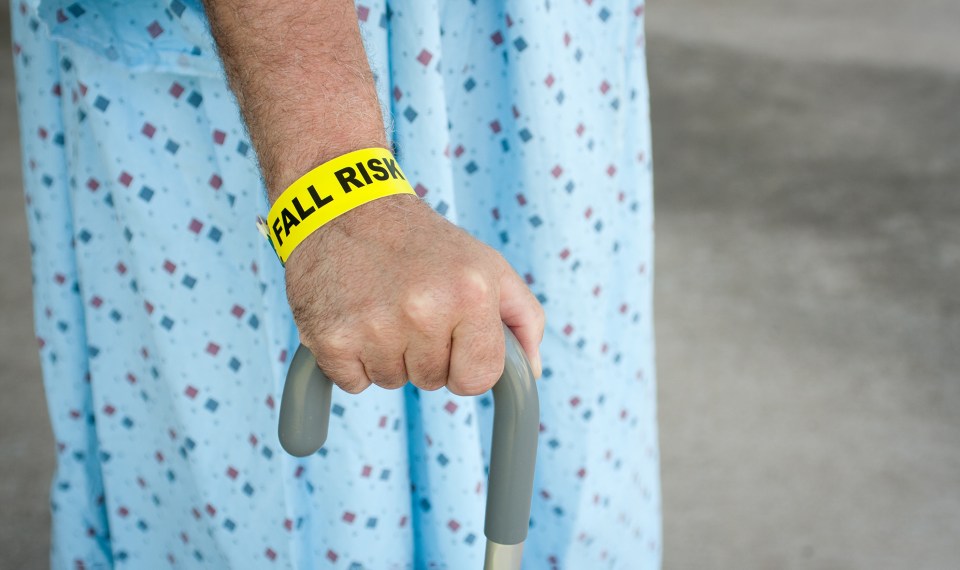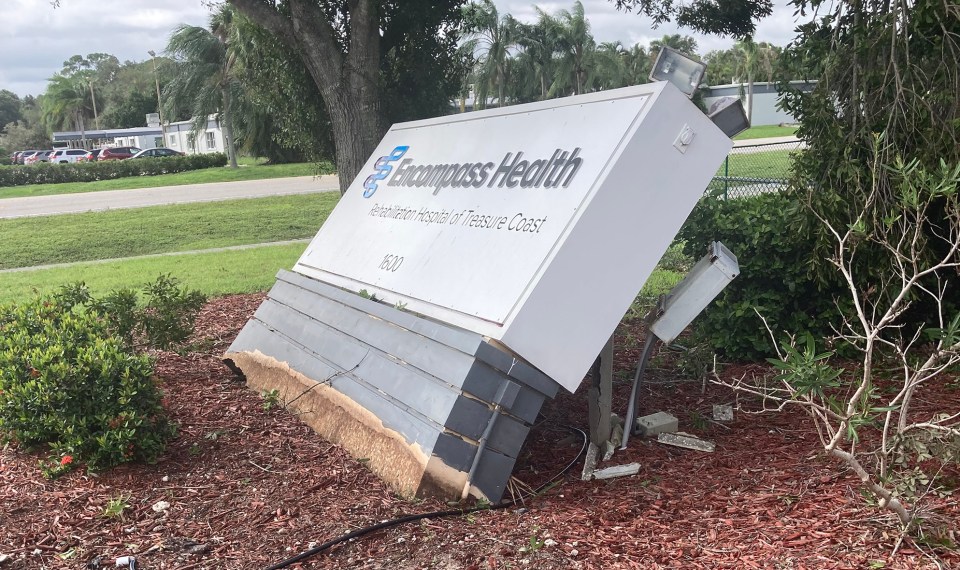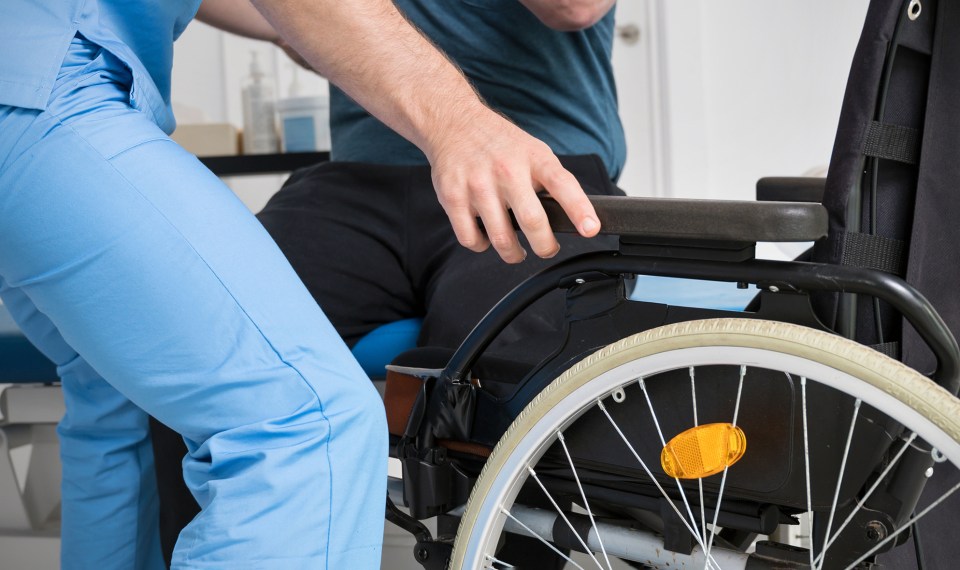Each year moderate to severe falls plague older adults. According to the CDC, they are a leading cause of injury for those 65 and older and can result in a hospitalization, disability and even death. Many older adults also have a fear of falling, which leads to activity restriction and decline in overall quality of life.
Physical therapists can do plenty to help improve balance and strength to prevent a fall, but by working with an interdisciplinary team and using a multi-factorial approach, we can also better understand why the fall occurred and identify resources to prevent a future one.
Fall Risk Factors
There are a variety of circumstances that put older adults at risk for a fall. They include:
- Chronic illness
- Confusion or decreased cognition
- Muscle weakness
- Difficulty walking
- Decreased balance
- Vision problems
- Foot pain/neuropathy or poor footwear
- Hazards around the home (throw rugs, clutter)
- Long hospital stays
- Polypharmacy (the use of five or more medications)
The good news is many of these risk factors can be modified or changed when an interdisciplinary and multi-factorial approach is taken to prevent falls.
Why an Interdisciplinary Approach?
An interdisciplinary approach, or team-based approach, is when a team of people from different disciplines work together to create an individualized rehabilitation program for the patient to provide the best care possible.
Using multiple approaches to fall prevention, as well as maximizing the strengths and skills of each discipline, will have a greater impact on preventing falls (Peek, Campbell, 2020, Biggs, D’Aurio, 2013). Each team member is integral for successful fall prevention during a patient’s course of stay at the hospital. It is critical that every employee within the hospital promotes a culture of safety.
At an inpatient rehabilitation hospital, such as Encompass Health, the interdisciplinary team includes a medical doctor, nurse, physical therapist, occupational therapist, speech therapist and case manager. Additional members are added based on each patient’s unique needs to ensure a comprehensive individualized care program is implemented.
Why a Multi-Factorial Approach to Fall Prevention?
A multi-factorial approach to fall prevention would mean more than just treating the injuries related to the fall; it would also address the underlying issues that caused the fall, as well as setting the patient up for success when they leave the hospital.
The care team assesses the patient’s medical status, functional ability and cognition to identify the patient as a high, basic or standard fall risk. This will determine what safety measures are incorporated into their care. Once evaluated, a multi-factorial approach will be implemented addressing the fall risks that have been identified by each discipline.
A multi-factorial approach should include (AHC Media, 2020; CDC, 2023; Elliott & Leland, 2018):
- An exercise program focused on improving strength, endurance, gait and balance reactions
- Recommendations for home safety modifications such as removing throw rugs and clutter, installing handrails in bathrooms and showers and improving lighting around the home
- Reducing polypharmacy if possible, especially medications that cause dizziness, lightheadedness or drowsiness
- Wearing non-skid footwear and socks or shoes that fit well and have a non-slip sole (avoid slippers, flip flops or backless shoes that can cause a tripping hazard)
- Patient and family education to ensure the safest discharge home possible
- Scheduling follow up doctors’ visits, including vision checks and screenings
Establishing Fall Prevention Guide and Assessments
Every hospital should have a fall prevention guide that emphasizes the importance of fall prevention and instills a commitment to patient safety that encompasses all aspects of a patient’s stay, especially in room comfort and care. The nursing staff should provide purposeful rounding as a proactive way to improve patient safety and satisfaction.
While in the room, the patient needs to be positioned appropriately, which involves assessing how long the patient has been in each position, providing pressure relief or repositioning opportunities and ensuring the patient is comfortable, with all personal needs met and items within reach.
Environmental risk factors should also be assessed. This includes clearing pathways of clutter, reducing unsupervised transfers or ambulation in the rooms, utilizing bed or chair alarms, relocating the patient closer to the nurse’s station and ensuring equipment, such as wheelchairs or assistive devices, are functional and safe.
If a patient does fall, they should be considered a high fall risk for the remainder of their stay; care should be adjusted accordingly. The clinical team should assess the fall and determine what additional safety measures are necessary, such as fall mats, lowering their bed, additional alarms (pressure chair alarm, bed alarm, seat belt), a one-on-one sitter, etc. (Parra, Rock, 2022).
The goal is to adapt the patient’s care to ensure that the risk of another fall is minimized.
Patient and Caregiver Education
When patient and family education coincide with therapy, the patient will achieve better outcomes in fall prevention by creating a safer and more sustainable discharge (Elliott & Leland, 2018; McGregor & Young, 2023). Communicating the patient’s current needs and identifying any potential barriers to a safe discharge allows a smooth continuum of care with the appropriate support provided as the patient transitions home.
Things for consideration include (Elliott & Leland, 2018, McGregor & Young, 2023):
- Change in medical condition. Is there a change in cognition? Are they showing symptoms of orthostatic hypotension? Does the patient require assistance with medication management?
- Home safety. What home hazards are present? What modifications are needed (grab bars, ramp, clearing pathways of clutter). Do they have proper footwear?
- Assistive devices or adaptive equipment. What is the safest assistive device for families to purchase that the hospital can’t order through insurance?
- Transportation. How much assistance is required to get in and out of a car? Does the patient have family/community support? How can the patient stay involved in the community? Can case management provide information on transportation services?
- Nutrition. Are there dietary concerns? Can the patient prepare meals? Are there services available near the patient’s home?
- Daily routines/household chores. What are the critical items required to continue living at home? What changes to the daily routine are needed? Can the care team provide energy conservation tips? Is there family/community support to complete tasks such as laundry, bathing, household cleaning and grocery shopping?
PT Evaluations
It is important that the physical therapy evaluation includes an assessment of the patient’s cognition level, a comprehensive medical history and balance assessment to accompany the strength and functional ability assessments already performed.
Cognition serves as the foundation for all skills. Several aspects of the patient’s cognitive function should be identified, so the goals and plan of care are appropriate and attainable. During the evaluation, consider the following:
- Attention: Can the patient attend to a task and perform complex movements or coordination?
- Perception: Can the patient perceive and respond to sensory information accurately? Is there decreased sensation or proprioception that impacts mobility?
- Memory: Can the patient recall the instructions given? Is the patient a reliable source of information (history, home environment, etc)?
- Executive function: Are the higher-level cognitive processes impaired, affecting adaptation to new tasks or movements?
- Anxiety: Does the fear of falling affect the overall sense of stability and willingness to participate?
Obtaining the patient’s medical history is important to diagnose the complex nature of a fall. Balance-related falls occur because of a slip or trip due to an extrinsic factor. Extrinsic factors can include no handrails on stairs, no grab bars in the bathrooms, dim lighting, obstacles such as pets, slippery/uneven surfaces or improper use of assistive devices. Unexplained falls are more intrinsic in nature and can be caused by orthostatic hypotension, dizziness or feeling faint (Palmer, Watkins, 2017; Menant, 2016). Additional intrinsic factors can include a history of falls, mobility impairments, use of an assistive device because of weakness or sensory loss in the legs, or medical conditions such as a stroke, dementia, frailty or depression (Wiemer, Slowman, 2021).
Because falls are usually a combination of intrinsic and extrinsic factors, it is better to use two balance assessments to evaluate the characteristics of a fall. The patient’s cognitive status and functional ability help to determine which balance assessments are appropriate. Common balance assessments include: Berg Balance Scale, Functional Reach Test, Romberg Test, Tinetti Gait and Balance Scale, TUG, ABC Scale, Mini BESTest (Wiemer, Slowman, 2021).
The PT’s Role
The best patient outcomes occur by using multiple approaches to regain a patient’s strength and balance, but it doesn’t end there.
The role for PTs and PTAs should also include (Mansfield, Wong, 2015; Inness, Mansfield, 2014; Wiemer, Slowman, 2021; Lesinski, Hortobagyi, 2015):
- Improving the patient’s reactions to unexpected gait perturbations
- Building patient confidence to overcome a fear of falling
- Functional training
- High intensity gait training
- Error augmentation
- Dual task activities
- Resistance exercises
- Fall prevention with perturbation-based balance training and fall techniques
Safe community mobility requires an individual to navigate unexpected tripping hazards and balance perturbations. As PT/PTAs, it is our job to improve our patients’ strength and challenge their balance during gait and functional activities at every interaction.
Even when a patient has achieved a high level of functional mobility, it is essential to train reactive stepping and postural balance to aid in fall reduction in order to improve the patient’s overall quality of life.
Falls are multi-factorial in nature and require a team of care providers to help reduce the risk of falls. No single discipline can be successful in reducing or minimizing fall risk in older adults; it takes an interdisciplinary team working together toward established goals.
A multi-factorial treatment plan that includes physical activity and education that is initiated in an inpatient rehabilitation setting and continued during the transition home, including physical therapy, occupational therapy, speech therapy (as appropriate) and regular doctors’ visits, is essential to give the patient the greatest chance of success upon discharge to the community.
As PTs and PTAs, we play a vital role in helping patients with their strength, balance, functional mobility and gait to be able to withstand unexpected fall risks in the community.
References
- Mansfield A, Wong JS, Bryce J, Knorr S, Patterson KK (2015) Does Perturbation-Based Balance Training Prevent Falls? Systematic Review and Meta-Analysis of Preliminary Randomized Controlled Trials. Physical Therapy.
- Center for Disease Control and Prevention (2023) Facts about Falls. National Center for Injury Prevention and Control.
- Inness EL, Mansfield A, Lakhani B, Bayley M, McIlroy WE (2014) Impaired Reactive Stepping Among Patients Ready for Discharge from Inpatient Stroke Rehabilitation. Physical Therapy
- Biggs J, D’Aurio L (2013) An Interdisciplinary Approach to Fall Prevention in Patients with Brain Injury. Rehab Management: The Interdisciplinary Journal of Rehabilitation
- Palmer E, Watkins L (2017) Falls in Older Adults. CINAHL Rehabilitation Guide EBSCO Publishing
- Peek GK, Campbell U (2020) Interdisciplinary Relationship Dynamics. American Journal of Health-System Pharmacy
- Parra K, Rock C, Aguirre M, et al. (2022) Fall Prevention Program Playbook. Encompass Health
- Eakman AM, Havens MD, Ager SJ, et al (2002) Fall Prevention in Long-Term Care: An In-House Interdisciplinary Team Approach. Topics in Geriatric Rehabilitation
- Elliott S, Leland N (2018) Occupational Therapy Fall Prevention Interventions for Community-Dwelling Older Adults: A Systematic Review. American Journal of Occupational Therapy
- McGregor M, Young L (2023) The Importance of Cognitive Screening. GeriNotes
- Wiemer H, Slowman LS (2021) Fall Prevention in Older Adults: Occupation Therapy. CINAHL Rehabilitation Guide EBSCO Publishing
- Menant JC, et al (2016) Depressive systems and orthostatic hypotension are risk factors for unexplained falls in community-living older people. Journal of the American Geriatrics Society
- Lesinski M, Hortobagyi T, Muehlbauer T, Follhofer A, Granacher U (2015) Effects of Balance Training on Balance Performance in Healthy Older Adults: A Systematic Review and Meta-Analysis. Sports Medicine
- AHC Media (2020) Falls Injure Millions of Americans, Cost $50 Billion Each year: Fall prevention is challenging. Case Management Advisor
- Pamela Baxter, Maureen Markle-Reid (2009) An interprofessional team approach to fall prevention for older home care clients “at risk” of falling: health care providers share their experiences. International Journal of Integrated Care.
The content of this site is for informational purposes only and should not be taken as professional medical advice. Always seek the advice of your physician or other qualified healthcare provider with any questions you may have regarding any medical conditions or treatments.




